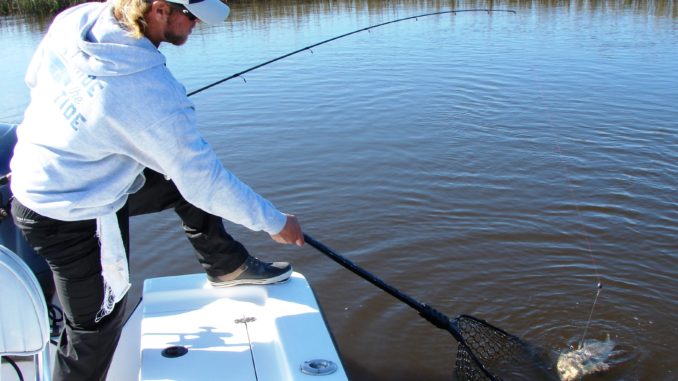
The three bays between the Federal Point boat ramp at Fort Fisher and Bald Head Island and the creeks that wander through and connect them are places well known for producing a variety of fish. When the winter chill and brisk winds set in, they become prime, protected fishing areas for many fishermen seeking red drum and speckled trout. Occasionally, their waters even warm enough the flounder rise out of their winter muds and feed.
These bays, marshes and creeks are special. The Basin and Second Bay are separated from the waves and currents of the Cape Fear River by a roughly 3-mile, rock breakwater simply called The Rocks, constructed by the U.S. Army Corps of Engineers in the late 1800s. While some water spills across and through several breaches, these bays and the marsh system are primarily fed by tidal exchange from the Cape Fear that enters through creeks behind Bald Head.
The Federal Point ramp is at the northern edge of the Basin. Its waters don’t fully exchange during a tide cycle, allowing water left in the shallow bay at lower tides to warm significantly from the sun shining on it and sections of exposed mud bottoms.
Much of the western edge of Second Bay is bordered by The Rocks, and the eastern edge has shallow marsh creeks meandering between the bay and the ocean beach. There is more tide exchange than in the Basin, plus, there are some breaks in The Rocks, so the open area of Second Bay may not be as warm as the Basin. Second Bay was connected to the ocean through Corncake Inlet, then New Inlet, but it closed during in 1999.
Buzzard Bay is in the marsh closest to Bald Head. It is a large, shallow bay fed only by tides from the Cape Fear River. It isn’t directly in the line of flow to Second Bay and the Basin, so there are parts of Buzzard Bay with minimal water exchange similar to the Basin. The combination of shallow depth, dark mud bottom and lack of a full-tide exchange helps keep it warmer during the winter, and once fish find it they rarely leave.
The abundance of shallow water, oyster rocks, sand bars and mud lumps help keep crowds down, especially during the winter when fishermen are much less willing to risk getting stranded. The tides get treacherously shallow on low tides, to the point of exposing bottom, on dark-moon phases. It takes a while to get comfortable running through this area, but there are a lot of excellent fishing opportunities.
Red drum move into the shallows to warm and feed, while speckled trout usually stay just off the flats in deeper water. There may be black drum mixed with either, and it isn’t a shock to catch a winter flounder. The combination of bays, flats and channels is an oasis for fish during the winter and while they sometimes get picky, there is usually a lure or bait that convinces them to feed.




Be the first to comment